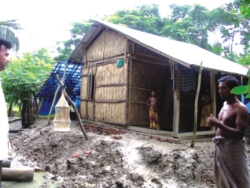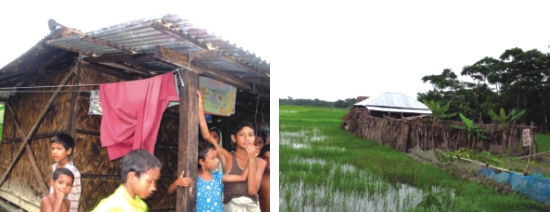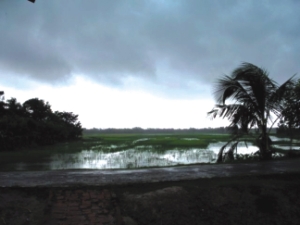|
Perspective
Nature's Humble Children
Opportunities from Destruction
Tahmina Rahman
"But I don't have a red one” said the woman when asked why she had come to collect yet another relief blanket when she already had so many.

How will these houses be maintained in the future? |
Sarankhola has been one of the worst affected of the regions hit by the cyclone SIDR in November of 2007. The death toll was catastrophic and destruction almost complete. The number of deaths only in Bagerhat district was 810, among the total estimated 3,363 throughout the country. The number of affected households there was 283,482; the highest in the country (source: MoFDM, Relief Control Cell, updated 27.12.2007). In Bagerhat most of the blow of the cyclone was taken by Sarankhola with Dular Char and Southkhali falling under it.
Life immediately after SIDR was miserable and very harsh. But gradually this situation improved. People got food and different relief items; later seeds, boats, fishing nets, rickshaw vans, cash to start small business and so on. And in the middle of the rainy season after a long period of waiting they got houses with C.I. sheet roofs that many took as blessing in return for the waiting. To have houses like these was beyond the dreams of many. Suddenly cash started to pour in this small unknown area from home and abroad. The number of NGOs working in Sarankhola jumped from only three to twenty four. Life in Sarankhola had changed.
This change has been brought by a lot of rebuilding; initially by relief, then by different short and long-term rehabilitation programmes. But looking carefully at what is happening, we can ask if it is really rebuilding? Or are the changes changing the pattern of life?
Normal life here evolves with nature. For many, the forest is directly or indirectly a part of livelihood. They collect honey, wax, wood, golpata and hogla from the forest. But after SIDR these activities have been restricted for two years to give nature time to get revitalised. The main livelihoods are fishing and agriculture. Mostly fishing is done in the wet season and agriculture during the rest of the year. People grow a lot of fruit and timber trees around the homesteads. They grow crops by storing rainwater. They are in harmony with nature in terms of their lifestyle and livelihood.

Life in Sarankhola has changed but not necessarily all of this change is good.
Interestingly, this place has direct bus service with Dhaka, farmers use power tillers, children are vaccinated, and almost all the children get some kind of education either in schools or madrasas. Mobile phone network covers the region and it played an important role after the disaster. Though electricity supply covers a very limited area, the service is excellent.
After SIDR the regular pattern of life has changed a lot. In its aftermath it got tremendous attention from all over. It would not be an exaggeration to say that since then aid in many forms have flooded the place. Communications concerning this place grew manifold. As a consequence, these nature oriented people got used to receiving relief. Many are still waiting for relief, not as much as from need but from the intoxication of it, taking it as manna from heaven.
There is therefore a flip side to receiving aid. Many have received regular rations long after the time they should have been earning their own. The limits of need have lost its boundaries with supply of things not a part of their lives or perhaps were of no need, i.e. knives and forks! Blankets go on being distributed and people are eager as ever to collect these, even if they had their requirements fulfilled.

The people of Sarankhola must now learn to get bach on their feet,
without aid.
With the opportunity to have their own houses people are moving away from the joint family structure to live as nuclear families. This is disintegrating the social and economic structure of the communities. As a result it will change the work distribution pattern, wealth sharing of the larger families, system of dependency of the elderly persons in the family, role of larger families where able members go out for work for days etc. The anticipation of outside help have made people reluctant about repairing or rebuilding their homes. Relief houses have been designed from the outside, lacking the participation or the implementation knowledge of the users. Thus there is an absence of a sense of belonging, a sense of ownership.

Normal life here evolves with nature. For many, the forest is directly or indirectly a part of livelihood |
The materials used in the aid houses, moreover, are not within the reach of the users. How these houses would be maintained in the future may pose a question. Will these be sold away to the affluent? The sustainable use and maintenance of materials could have been a priority in designing these homes. House construction may have been delayed for the restriction on collection of golpata. But people need not be solely dependent on forest materials here. Excess of aid has reduced the natural instinct to rebuild, the spirit to stand up again.
It may be assumed from these changes that perhaps help is not always reaching the right people, or in the right form. Word of mouth is changing to promises, and every outsider is viewed as a candy man to the recipients. But better coordination of aid could have made these changes more meaningful.
Whether such change has been good or bad for the community cannot be judged right now. Only time will tell. It has been almost a year since the cyclone and people should be earning their lot by now and not living on aid. The free commodities may block their will for resilience. If it does that, then the long-term development would not be significant no matter how good the intentions are. The issue of long-term sustainability is also of concern. The infrastructures and social amenities although not good enough are definite signs of development. Flow of money is not the only thing necessary for development. But money is certainly an opportunity. Managing it properly to ensure the proper economic and social growth in this area might need better planning. Should not this chance be handled a bit more carefully?
Tahmina Rahman. is an architect and a student of the Post Graduate Programmes in Disaster Management, Brac University.
Copyright
(R) thedailystar.net 2008 |
